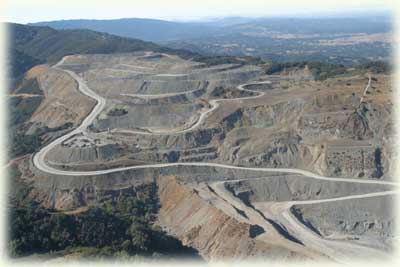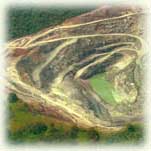|
 News News
 Subscribe to Our Newsletter Subscribe to Our Newsletter
 Sign up for Email Updates
Sign up for Email Updates
 CGF In the News
CGF In the News
 Press Inquiries Press Inquiries
 Past Articles Past Articles
 Calendar Calendar

Get involved!Read the CGF action alert
on the quarry scarring of the hillsides.
|
|
|
A scar above Santa Clara County:
Quarry operations threatening foothills
by Jitze Couperus and Brian Schmidt

When Committee For Green Foothills was formed more than 40 years ago, one of the primary motivations was to "keep the
factories out of the foothills" and thus preserve those hills as a scenic backdrop for the residents of what later became Silicon Valley.  The Hanson Quarry (formerly known as the Kaiser Permanente Cement Plant) is working 3,500 acres in Cupertino, where a huge
scar mars the hillside. CGF and neighbor activists are watching a number of other environmental problems with the quarry. Today, these foothills still need our protection. Perhaps one of the
most obvious examples is the huge scar of rock and dirt up in the
hills behind Los Altos, Mountain View and Cupertino. This is not just a little grading, but a huge denuded gash that can be seen from as far away as Alviso and Milpitas. The scar has been
expanding and becoming ever more visible for some years now -- despite the view protections that we thought had been agreed upon between Santa Clara County and the owners of the land.
Sadly, this scar is evidence of just one of the quarry's three large environmental violations -- the scar, violation of a ridgeline easement, and landslides onto public property -- all of which
encroach on public views of the hillsides. Waste material creates obvious scar
What is this scar, and who is responsible? The operation in question was for a long time known as the Kaiser Permanente
Cement Plant. In 1987, the plant was purchased by Hanson, a
British building materials company that currently works the 3,500 acres. Annually, Hanson mines around five million tons of rock, approximately one-third of which becomes cement, one third that
becomes aggregate for use in concrete and a third of which is waste. Over the years, development on this site has become all too apparent from the valley below, in the form of a mile-long scar
covering the ridgeline. Hanson is creating this scar largely through the deposition of waste rock (overburden) piled high on top of (and behind) the ridge at the northern end of the quarry. Quarried
rock is trucked out of the lower parts of the quarry and dumped at the top in a series of tiers, somewhat like those on an elaborate wedding cake -- made of many thousands of cubic yards of rock waste.  As seen from the valley below, the long horizontal scar has three
components. The lower part is an area of scraped, bare dirt with little or no vegetation. Just above this an access road has been graded for dump trucks, and behind that rise the massive tiers of
deposited waste rock. Hanson Cement informs us that this dumping of rock at the summit of the quarry is expected to continue for at least another year. Easement not providing adequate protections
While this visible scar from quarry operations appeared only in recent years, people anticipated decades ago that the quarry could transform green hillsides into rock wastelands. To limit this
problem, an agreement was reached with the quarry owners in 1972 for the dedication of a Ridgeline Protection Easement. The purpose of this easement was to preserve a ridgeline from being
torn out by the quarry, as that ridgeline shields the massive quarry operations from public view. The easement covers a sector near the middle of the quarry's
length. Unfortunately, the easement does not protect the area now being scarred with rock waste. However, even the limited protection afforded by the easement in its own area appears to have been violated.
To mark the protected elevation level, four fixed monument markers were installed; the easement prohibits the quarry from lowering the ridgeline below this marked elevation. But two of the
monuments marking the agreed ridgeline have apparently disappeared, and a series of landslides have moved vast quantities of dirt in the vicinity of the ridgeline. Quarry walls tumbling down
If you can imagine how an ever-widening cavity in a tooth will eventually cause the collapse of the walls around the cavity, you can get an idea of how part of the sidewall of the largest pit in the
quarry gave way and slid into the pit. The quarry's own geologists estimated that an eventual total of around 3.5 million cubic yards of rock material could give way. Indeed, in the last three years,
there have been three landslides in the area.

|
Landslides from the quarry may have done more than violate the ridgeline easement. The
Midpeninsula Regional Open Space District
(MROSD) owns land adjoining the quarry, and records from Santa Clara County suggests that landslides from the quarry have slid onto MROSD property. If this is the case, the landslides from the quarry are a "trespass" onto public property, and another violation of the public's rights.
|
Negotiations not yet showing results -- it's time for solutions
For some time now, Committee for Green Foothills has been
researching and discussing these problems with concerned citizens, government officials and the quarry operators. Both Santa Clara County and MROSD have been negotiating with the
quarry, but these negotiations have achieved little to date. It seems clear that we need the public to speak up and demand solutions to these problems. We have asked the County and
quarry operators to address three specific issues:
1. Let the public know if its rights have been violated.
CGF has asked Santa Clara County to confirm publicly whether
the ridgeline protection easement has been violated, which is almost certainly the case. MROSD should do the same with respect to the quarry's potentially releasing landslides onto
MROSD property. While the Committee has no reason to believe that the government agencies are mishandling or concealing these problems, the public should be involved in protecting its property rights.
2.
Solve all three public violations.
All three of these environmental encroachments are related: the ridgeline scarring and overburden dumping, the ridgeline easement
violation and the landslides onto public property all mar the hillsides and affect public views. Should the quarry operators be found guilty of any of these violations, it would likely be extremely
expensive for them to rebuild and stabilize the ridgeline at the elevation level protected by the easement.
If the quarry operators want the public to accept something less
than our full rights regarding the ridgeline easement and other violations, the appropriate trade is that the quarry should decrease visual impact from the overburden hillside scar.
3.
Find specific solutions for hillside scarring.
The quarry operators expect to stop placing overburden on the visible hillside and begin revegetating the area within the next two
years. CGF believes that we need a legal deadline for ending the scarring as soon as possible.
In addition, the quarry should make binding commitments not to
place overburden in any areas visible from the valley floor. Finally, the quarry should speed up the revegetation process by dividing the overburden area into different sections, and work in only one
section at a time while revegetating the other sections. Are quarries appropriate in our hills?
Problems with quarrying in the hillsides go far beyond this one
hillside scar and Hanson's potentially illegal acts. Because this particular quarry began operations more than 60 years ago, before the County had regulations for such operations, it is not
required to have a County permit. Other quarries that initiated operations more recently would be subject to more direct County oversight by way of permit requirements.
Ultimately, Santa Clara County needs to decide whether massive industrial quarries such as this are compatible with the open space recreation and environmental value that people place on the County's hillsides.
Committee for Green Foothills will continue to monitor quarry operations, work toward solutions to these particular problems and take any needed steps to protect our hillsides.
Published March 2004 in Green Footnotes.
Click
here to see additional photos about the quarry. Click
here to read our action alert on this issue and find out how you can get involved.
Page last updated April 19, 2004 |
|
![]()
![]()




